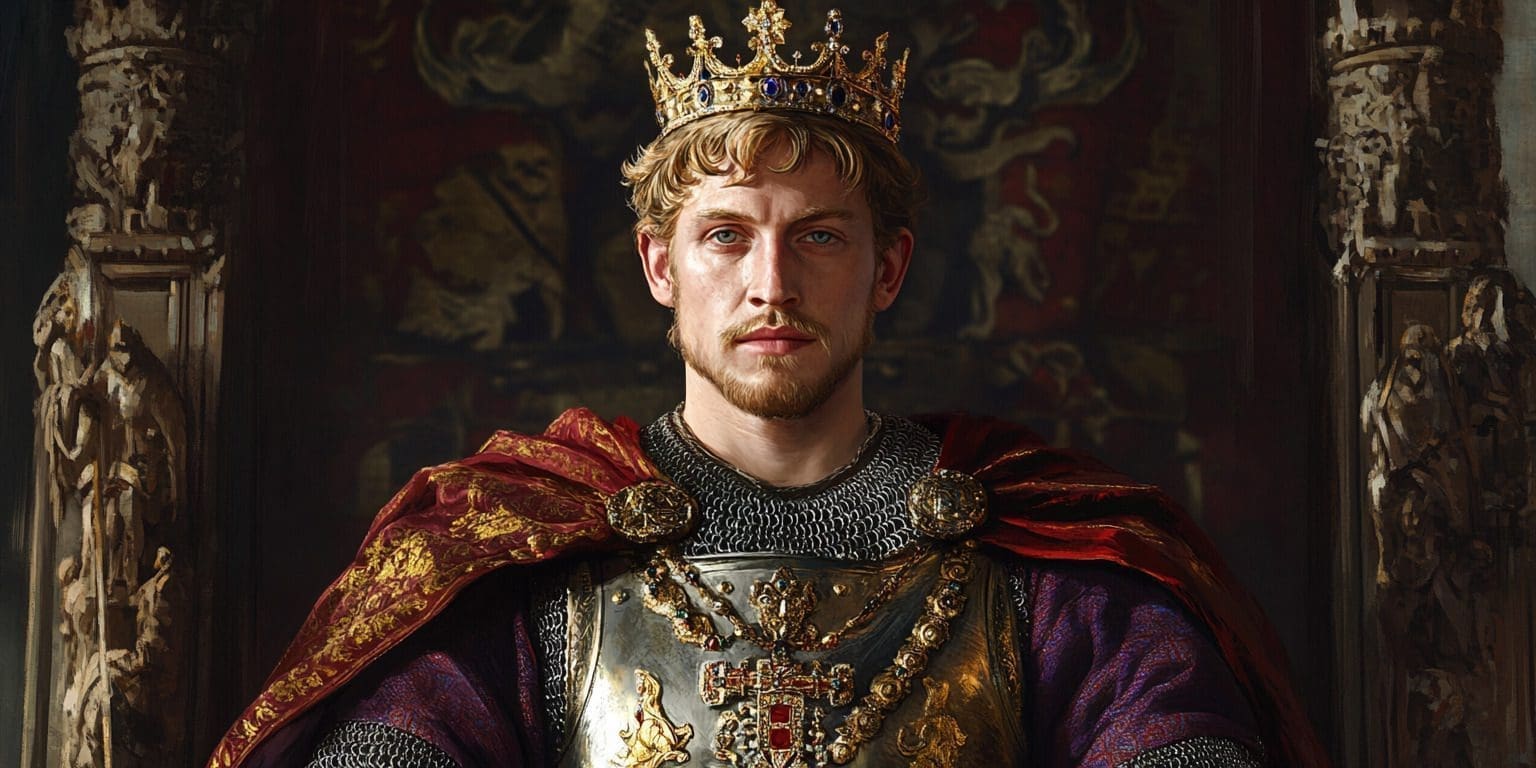Who Was King Edward II?
King Edward II, born in 1284, was a figure who left an indelible mark on English history. Son of the formidable King Edward I, he ascended to the throne in 1307. But unlike his father, Edward II’s reign was fraught with controversy, military failures, and internal strife.
Why Is King Edward II Controversial?
His reign was a rollercoaster of ups and downs, marked by a series of poor decisions and conflicts with the nobility. From his close relationship with Piers Gaveston to the disastrous Battle of Bannockburn, Edward II seemed to be a magnet for controversy.


The Royal Birth and Lineage of King Edward II
Born on 25 April 1284 in Caernarfon Castle, Wales, Edward of Caernarfon, later known as King Edward II, was no ordinary child. He was the fourth son of King Edward I, also known as “Longshanks,” and Queen Eleanor of Castile. His birthplace itself holds historical significance, as Caernarfon Castle is one of the most impressive medieval fortresses in Britain, a topic we’ve covered in our history of Caernarfon Castle article.
Education and Upbringing: The Making of a Future King
Edward’s early education was typical for a royal prince of his time. He was tutored in various subjects ranging from Latin and history to the art of warfare. However, unlike his father, who was a seasoned warrior, Edward showed more interest in the arts and leisure activities. This difference in temperament would later become a point of contention between the two.
The Influence of His Father, King Edward I
Edward I was a formidable ruler, known for his military prowess and strong governance. His influence on young Edward was profound but also complex. While Edward II admired his father, he often found it challenging to live up to the high standards set by him. The father-son relationship was a mix of admiration and tension, a dynamic that would play a significant role in shaping Edward II’s character and reign.
Early Signs of Controversy: The Piers Gaveston Friendship
Even in his formative years, Edward II showed a penchant for forming close, and often controversial, relationships. The most notable among these was his friendship with Piers Gaveston, a Gascon knight. This friendship, which began when Edward was just a teenager, would later become a major talking point of his reign and contribute to his controversial status.
Why Understanding Edward II’s Early Life Matters
Understanding the early life of King Edward II is crucial for anyone looking to grasp the complexities of his reign. His upbringing, education, and early influences offer valuable insights into the man he would become. They set the stage for a reign filled with drama, conflict, and moments that would change the course of English history.


The Coronation: A New King Takes the Throne
On 20 July 1307, Edward II was crowned King of England at Westminster Abbey. The coronation was a grand affair, filled with all the pomp and circumstance you’d expect for a royal event. But behind the glitz and glamour lay a kingdom fraught with challenges. Edward II had big shoes to fill, succeeding his father, the formidable King Edward I.
The Kingdom Inherited: A Mixed Bag
When Edward II took the throne, England was a kingdom of contrasts. On one hand, it was a prosperous nation with a strong military. On the other, it was embroiled in conflicts, most notably the ongoing wars with Scotland. Edward II inherited a kingdom that was both powerful and problematic, setting the stage for a reign that would be anything but smooth sailing.
Initial Challenges: The Nobility and Piers Gaveston
One of the first hurdles Edward II faced was managing his relationship with the English nobility. His close friendship with Piers Gaveston, whom he appointed as the Earl of Cornwall, didn’t sit well with the barons. This early decision to favour Gaveston was a sign of the conflicts that would mar his reign.
The Expectations: Living Up to a Legacy
Edward II was not just any king; he was the son of Edward I, a ruler known for his military successes and strong governance. The expectations were sky-high, and the new king had to navigate the weight of this legacy. Would he be a worthy successor, or would he falter under the pressure?
The Significance of Edward II’s Early Reign
The initial years of Edward II’s reign were a critical period, laying the groundwork for what was to come. His choices, especially his relationship with the nobility and his handling of ongoing conflicts, set the tone for his rule. Understanding this phase is key to grasping the complexities of his controversial reign.
The Piers Gaveston Saga: The Friendship that Shook Medieval England
Who Was Piers Gaveston?
Piers Gaveston was a Gascon knight who caught the eye of the young Edward II. Their friendship began when Edward was still a prince and quickly blossomed into a close, almost brotherly, bond. But who was this man who became so integral to the life and reign of King Edward II?
The Rise of Gaveston: From Knight to Earl
Soon after his coronation, Edward II made a bold move by appointing Piers Gaveston as the Earl of Cornwall. This was a high-ranking title, often reserved for members of the royal family or the English nobility. The appointment didn’t just raise eyebrows; it led to outright opposition from powerful barons.
The Nobility’s Discontent: A Brewing Storm
The English nobility was far from pleased with Gaveston’s rapid rise. They viewed him as a foreign upstart who had too much influence over the king. This discontent soon turned into a full-blown crisis, leading to Gaveston’s multiple exiles and eventual execution.
The Impact on King Edward II’s Reign
The friendship with Gaveston had a profound impact on Edward II’s rule. It not only strained his relationship with the nobility but also led to political instability. The Gaveston saga was a turning point, setting the stage for the conflicts and controversies that would define Edward II’s reign.

Why the Gaveston Friendship Matters in Understanding Edward II
The relationship between Edward II and Piers Gaveston is more than just a tale of friendship; it’s a lens through which we can understand the king’s character and leadership style. It highlights his tendency to favour personal relationships over political prudence, a trait that would have far-reaching consequences.
Military Failures: The Battle of Bannockburn and King Edward II’s Struggles on the Battlefield

The Scottish Wars: A Thorny Legacy
When Edward II took the throne, England was already embroiled in a series of conflicts with Scotland. His father, King Edward I, had initiated these wars with the aim of asserting English dominance. However, the young king found himself inheriting a military challenge that would prove to be one of his greatest tests.
The Battle of Bannockburn: A Turning Point
In 1314, Edward II led an army into Scotland, aiming for a decisive victory at the Battle of Bannockburn. Unfortunately, the battle was a disaster for the English. Not only were they defeated, but the loss also had a devastating impact on Edward II’s reputation as a military leader.
The Aftermath: Loss of Prestige and Territory
The defeat at Bannockburn was more than just a military setback; it was a blow to English prestige. Scotland regained control of key territories, and Edward II faced criticism from both his nobles and the general populace. The loss also weakened his standing among European monarchs, further complicating his reign.
The Domino Effect: How Bannockburn Influenced Edward II’s Reign
The failure at Bannockburn had a domino effect on Edward II’s rule. It led to increased dissatisfaction among the nobility and even sparked rebellions. The king’s inability to secure a military victory added fuel to the already simmering discontent, making his position increasingly precarious.
Why Understanding Bannockburn is Key to Edward II’s Story
The Battle of Bannockburn wasn’t just a standalone event; it was a defining moment in Edward II’s reign. Understanding this military failure helps us grasp the complexities and challenges that marked his time on the throne. It serves as a lens through which we can view the broader issues that plagued his rule.

Governance and Domestic Policies: King Edward II’s Rule at Home
One of the defining traits of Edward II’s governance was his reliance on personal relationships. Whether it was his friendship with Piers Gaveston or his later association with Hugh Despenser, the king often placed personal bonds above political wisdom. This approach had a significant impact on his domestic policies and governance style.
Relations with Parliament: A Rocky Road
Edward II had a complicated relationship with the English Parliament. His tendency to favour close associates led to multiple clashes with the nobility, who often used Parliament as a platform to voice their discontent. The tension reached a peak when Parliament forced the king to agree to reforms, limiting his powers.

The Church and Edward II: A Delicate Balance
The king’s relationship with the Church was equally complex. While he sought the Church’s support to bolster his rule, his actions often led to friction. The most notable example was his conflict with Archbishop Thomas of Canterbury, which further weakened his standing among influential religious figures.
Economic Conditions: Prosperity or Decline?
Edward II’s reign was a period of economic volatility. While trade with Europe initially flourished, military failures and internal strife took a toll on the economy. High taxes and the devaluation of currency led to public unrest, adding another layer of complexity to his rule.
The Impact of Domestic Policies on Edward II’s Legacy
The king’s domestic policies were a mixed bag of successes and failures. While he did have some achievements, like the establishment of trade fairs, his governance was largely marked by instability and conflict. These domestic challenges played a significant role in shaping his controversial legacy.
Why Understanding Edward II’s Governance Matters
To fully grasp the enigma that is King Edward II, it’s crucial to understand his governance and domestic policies. These aspects offer valuable insights into his character and the challenges he faced as a ruler. They also help explain why his reign was so fraught with controversy and conflict.
The Downfall: Conflicts, Imprisonment, and the End of King Edward II’s Reign
The Rise of Roger Mortimer: A New Adversary
As if Edward II didn’t have enough on his plate, along came Roger Mortimer, a powerful baron who would become one of his fiercest adversaries. Mortimer was initially a loyal supporter, but he grew disillusioned with the king’s governance, especially his favouritism towards Hugh Despenser. This set the stage for a conflict that would be pivotal in Edward II’s downfall.
Internal Conflicts: The Nobility Strikes Back
Edward II’s strained relationship with the nobility reached a boiling point when Mortimer and Queen Isabella, Edward’s own wife, led a rebellion against him. The king was captured and imprisoned in Berkeley Castle, marking a dramatic turn in his already tumultuous reign.
Imprisonment and Forced Abdication: The Final Blow
While imprisoned, Edward II was forced to abdicate the throne in favour of his son, who would become King Edward III. This was a devastating blow, effectively ending his reign and reducing him to a mere footnote in the annals of English history.
The Mystery Surrounding Edward II’s Fate
What happened to Edward II post-abdication is shrouded in mystery. While some historical accounts suggest that he was murdered in prison, others believe he may have escaped and lived out his days in obscurity. The uncertainty adds another layer of intrigue to his already complex story.
The Legacy of Edward II’s Downfall
Edward II’s downfall wasn’t just the end of his reign; it was a watershed moment in English history. It led to a shift in the balance of power between the monarchy and the nobility, setting the stage for future conflicts and governance reforms.
Why the Downfall of Edward II is Crucial to Understanding His Reign
Understanding the circumstances and key players in Edward II’s downfall is essential for anyone looking to grasp the complexities of his reign. His abdication and the events leading up to it offer a lens through which we can view the broader issues that plagued his rule.
The Mysterious Death and Legacy of King Edward II: The Final Chapter in a Controversial Reign
The Enigma of Edward II’s Death: Fact or Fiction?
The circumstances surrounding Edward II’s death are shrouded in mystery and speculation. While some historical accounts suggest he was murdered in Berkeley Castle, others propose that he escaped and lived in anonymity. This uncertainty has led to various theories, each adding a layer of intrigue to his already complex life story.
Theories and Legends: Sorting Fact from Fiction
Over the years, numerous theories have emerged about Edward II’s fate. Some say he was killed by a red-hot poker, a gruesome end that has captured the public’s imagination. Others believe he managed to escape and lived out his days in Italy. While the truth remains elusive, these theories contribute to the enigmatic aura that surrounds Edward II.
The Legacy Left Behind: A Reign to Remember
Despite the controversies and failures that marked his reign, Edward II’s legacy is far from forgotten. He remains a subject of study, debate, and even admiration. His life and times have inspired plays, books, and films, ensuring that he continues to be a part of England’s cultural and historical landscape.





